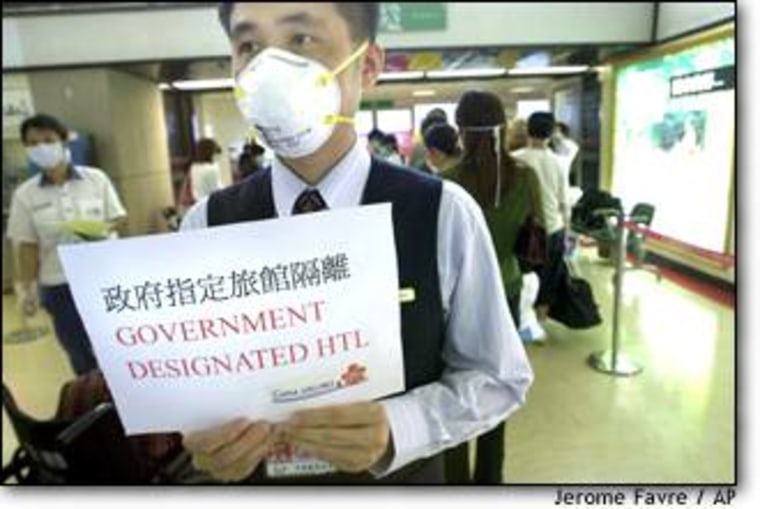In Milan in 1374, plague victims were ordered to a field outside the city, either to die or recover. Four hundred years later, Egyptian authorities sent the sick to pesthouses and shot heads of families if they didn’t report a disease victim in their midst. As archaic as it seems, quarantine remains the first line of defense against deadly viruses spread from person to person — from the Black Death of the Middle Ages to SARS now.
“It is a time-tested way of stopping or impeding the transmission of disease,” said Larry Gostin, a public health professor at Johns Hopkins University.
But if the modern quarantine shares the goals of ancient medicine, the methods have changed.
Centuries before today’s SARS outbreak, lowly sanitariums, brutal coercion and race-based roundups often formed the basis for responding to out-of-control disease. Thousands paid the price so millions could live.
An excuse to discriminate
History’s medical outcasts include children torn from their families, Indians of the American west driven to hardscrabble lands, lepers consigned to a lifetime of isolation, sailors left adrift in harbors.
“Plagues bring out the worst in people, trigger stereotypes, prejudices and irrational fears,” Gostin said “These can easily get out of control, and people use disease as an excuse to discriminate.”
In China, where SARS surfaced, about 16,000 people have been quarantined in Beijing alone. Thousands have been temporarily quarantined in Canada, too. In the United States, where the government recommends isolation of SARS patients but does not compel it, severely ill patients are being cared for in hospitals and the mildly ill in their homes.
But severe acute respiratory syndrome has been added to the list of communicable diseases for which isolation or quarantine can be authorized in the United States if necessary. The other diseases are cholera, diphtheria, infectious tuberculosis, plague, smallpox, yellow fever and viral hemorrhagic fevers.
40 days of confinement
Quarantine — derived from the Latin through Old French and Italian — refers to 40 days.
Its origins date to the 14th century, when sailors arriving at the port of Venice from places smoldering with bubonic plague were confined on their ships for 40 days. Stirred by the Black Death, officials in Italy and southern France created a system of sanitary controls with observation stations, isolation hospitals and disinfection procedures.
In London, many poor people festered in their plague-stricken communities while the wealthy fled to country retreats for recuperative doses of fresh air and sunshine.
Class often was a determining factor in how quarantines were handled. Hundreds of years later, in the 1800s, the Ottoman ruler of Egypt, Mohammed Ali, let wealthier families with plague victims stay in their homes while rounding up the poor and taking them to quarantine stations.
Heads of households who failed to report that a family member had died of plague were shot, Sheldon Watts says in his book “Epidemics and History.” Still, the Egyptian epidemic killed 200,000 people.
The largest scale quarantines were for tuberculosis through the 19th and 20th centuries in Europe. Victims were sent to special facilities outside cities.
Cholera killed people by the tens of thousands in Paris, London and Stockholm, Sweden, in the 1830s, and moved with emigrants to North America. Throughout Europe, police, soldiers and medical officials enforced quarantines. The rich locked themselves in relatively clean houses or in isolated country retreats.
Legacy of Typhoid Mary
In the United States, yellow fever and cholera outbreaks in the late 1800s spurred the federal government to tighten control over quarantines that had been left mainly to local authorities.
In Muncie, Ind., a smallpox outbreak in 1893 led to the quarantine of many infected citizens, kept under home detention. Entire neighborhoods were sealed by armed guards; violators were put in prison.
Probably no one personifies the unwilling quarantine subject more than Mary Mallon, an Irish immigrant cook known as Typhoid Mary, who was banished for 26 years to a cabin on New York’s North River Island. Suspected of having infected nearly 50 people, three of whom died, she denied until her death in 1938 that she had carried typhoid fever.
In 1900, a quarantine was ordered in San Francisco’s Chinatown after plague was diagnosed there. The boundaries were arbitrarily established to include only Chinese households and businesses.
The result was severe economic damage to the once-thriving Chinese business community. A federal court found the quarantine unconstitutional.
Quarantines also grew out of a need to isolate leprosy, now known as Hansen’s disease. About 8,000 people were exiled to the tiny Hawaiian island of Molokai until a law was repealed in 1969 that forced people with leprosy or anyone suspected of having it to be secluded on land that was set apart.
